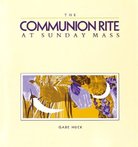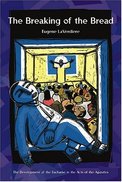Eucharistic Elements
Our liturgical instructions require that the bread and wine for use in the Eucharist "truly have the appearance of real food." The elements were originally provided by the faithful and carried from their homes. Having members of your parish community bake the bread themselves (and if possible also make the wine!) is an excellent way to connect the Eucharist to daily life, stewardship, and the traditions of the early Church.
Key Insights
|
Real Food
The General Instruction on the Roman Missal calls for the eucharistic elements to "truly have the appearance of real food." Use something that could be recognized as bread instead of the commonly used wafers. Logistics
The convenience of wafers is obviously part of their great appeal (most would not claim it's their taste). There are certainly logistical issues involved, but they can be easily overcome, as many churches who regularly bake their own bread have shown. |
Work of Our Human Hands
The Procession of the Gifts ritualizes the experience of the early Church of the faithful physically bringing various gifts from their homes to the liturgy, including the bread and wine. We pray over the gifts as the "work of human hands," so it would be more fitting that the elements be the work of someone within the community, rather than mass-produced on a machine across the country. Locally made bread also more easily meets the requirement (in the General Instruction) that the bread be "recently made." |
Just Try It
It can feel overwhelming to commit to making bread for every Sunday. Instead, just commit to trying it for one Mass or on an occasional basis (e.g. the feast of the Body and Blood of Christ, when celebrating first communions, or during Lent). Based on the response, you may feel compelled to transition next to once a month or every week. Ministry of Baking
Parishes concerned about finding volunteer bakers may be surprised. The uniqueness of this ministry can willingly attract those who are not otherwise involved. |
Quotations
319. Following the example of Christ, the Church has always used bread and wine with water to celebrate the Lord’s Supper. General Instruction on the Roman Missal
Second Vatican Council |
A seminary pal of mine once remarked that he had no difficulty believing that Christ is present in holy communion. What he did question was the proposition that it was actually bread being used as a host. Believe it or not, the hosts we use at Mass qualify as “real bread,” but they aren’t very good bread—at least not in any ordinary, earthly sense of the word. John Switzer
U.S. Catholic The bread is to appear to the senses as food. We are quite simply to recognize bread. This is spelled out in the General Instruction of the Roman Missal....This is a statement about texture, shape, taste, even smell. Because this statement is juxtaposed with the requirement that the bread be unleavened and with the instructions in other documents that it be made from wheat flour and water only, there is a great challenge. Some ignore the instruction that the bread "appear as actual food" and continue to use thin wafers. Others ignore the restrictions on ingredients. Still others insist that we live with both instructions -- though not without some effort. Some have devised recipes for such bread and have created a ministry of bread baking in the parish. Some have saught out places that offer mass-produced (excuse the pun) breads, but with greater size, texture and taste to them. The Communion Rite at Sunday Mass
Gabe Huck The New Testament writers agree that Jesus' Last Supper occurred within a Passover context. Given the ritual requirements of this feast, Jesus and his disciples probably at the flat barley cakes of the Passover festival at their last meal together. The New Testament does not attach any significance to the use of unleavened bread, and little evidence exists that the early community continued to use such bread in their eucharistic gatherings. More probably, the barley bread eaten at daily meals became the staple for eucharistic meals as well. From Age To Age
Edward Foley Be gentle when you touch bread. Author unknown
Printed in More-with-Less Cookbook |
The gifts are then brought forward. It is desirable for the faithful to present the bread and wine, which are accepted by the priest or deacon at a convenient place....Even though the faithful no longer, as in the past, bring the bread and wine for the liturgy from their homes, the rite of carrying up the gifts retains the same spiritual value and meaning. General Instruction on the Roman Missal (#49)
Blessed are you, Lord, God of all creation. Liturgy of the Eucharist
One of the most ancient customs of the Church is that of the people themselves providing the bread and wine for the eucharist. In third century Rome the deacons carried and presented to the bishop the gifts brought by the faithful.... As the Roman liturgy spread to other lands, this rite became a true procession of all the people who brought forth not only bread and wine but at times also oil, candles, wheat, grapes, and other items of precious value.... Although traces of the procession continued down to the end of the Middle Ages, the presentation of bread and wine by the faithful was, from the eleventh century, generally replaced by the giving of money. The Order of the Mass has restored the procession in a simple form. The Mystery of Faith: A Study of the Structural Elements of the Order of Mass
Federation of Diocesan Liturgical Commissions The tradition of baking communion bread is long gone. No one has time for such things. Religion has become efficient.... There’s no color, no fragrance, no texture and no taste. The symbol for the Christ the children are to learn to love and know will be tasteless, almost intangible, certainly uninviting, all materiality thinned, leaving his humanity untouched, while demanding respect for divinity. Rosalie De Rosset
|
Bread Recipes
Books

The Communion Rite at Sunday Mass
Gabe Huck The communion rite at the parish's Sunday Mass is to have a movement of word, music and gesture from the Lord's Prayer through the prayer after communion.This book looks at every aspect of the communion rute and shows how strong and beautiful it can be at every Mass in every parish. Supplementary materials enrich the basic text with background and practical help. Photographs provide fine images of this rite. (Amazon) |

The Breaking of the Bread: The Development of the Eucharist According to the Acts of the Apostles
Eugene LaVerdiere, S.S.S. As shown in Father LaVerdieres first volume, Dining in the Kingdom of God, Luke's Gospel is a chronicle of Jesus journeys and meals along the way to Jerusalem. From the placing of the infant Jesus in a manger (where animals feed) to the meal the risen Christ shared with his disciples before the ascension, Luke's Gospel is a story of meals. The second part of Luke's chronicles, the Acts of the Apostles, continues the narrative of meals, hospitality, and Eucharist in the life of the early Church. LaVerdieres eloquent scholarship makes the wonders of Luke's work accessible to all and helps us to understand the Eucharist as liturgy and as life. (Amazon) |
Articles
- Can We Use Real Bread at Mass? (U.S. Catholic)
- In the baking of the bread: making the bread that becomes Christ's Body gave me a new appreciation for the Eucharist (Renee M. Lareau)
- Prayerful bread-baking instructions used by a Lutheran church (Calvary Lutheran Church, Minneapolis)
- Bread-baking prayer (RevWho)
Header photo shows "The Last Supper" by Polish artist Bohdan Piasecki.
